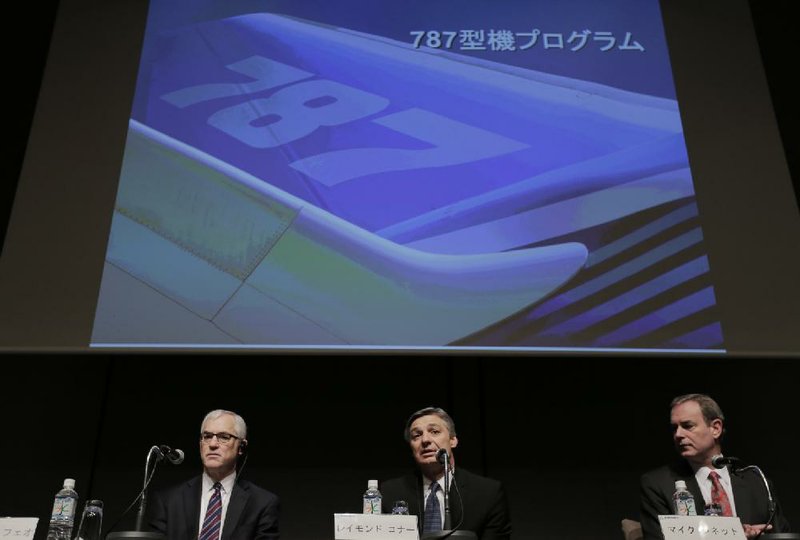TOKYO - Boeing said a proposed redesign of the 787 Dreamliner’s battery systems could allow commercial flights to restart within weeks after two incidents had caused the plane to be grounded for two months.
The battery now has extra safety measures, including a new enclosure and adjustments to the charger, Boeing said in a statement in Tokyo on Friday. The device will undergo more rigorous tests and its manufacturer GS Yuasa Corp. had fully cooperated in the process, Ray Conner, head of Boeing’s commercial planes division, said at the event.
GS Yuasa shares rose the most in a week after the announcement from Boeing, whose proposed redesign of the battery system was cleared by U.S. regulators this week. While Boeing says no date has been set for the 787 to carry passengers again, the fixes may allow the worldwide fleet of 49 Dreamliners to return to flight after overheating and smoke from two lithium-ion batteries led to the first grounding of a model in 34 years.
“It is reasonable to expect that we could be back up and going in weeks, not in months,” Mike Sinnett, vice president and chief project engineer of the 787 program, told reporters in Tokyo. “We understand the work to be done and we’ve got a fairly good notion of how long it will take, and if we miss, it will be by a little, not by a lot.”
Boeing will be allowed“limited test flights” with two 787s that will have prototype components of the new battery system, the Federal Aviation Administration said March 12. Boeing must prove in flight and laboratory tests that the design meets U.S. standards, and the FAA could insist on more changes, the agency said in a statement.
About 25 percent of Boeing’s testing is already underway or has been completed, while 75 percent of the aircraft maker’s test plans have been approved, Sinnett said.Resumption of Dreamliner flights will depend on testing and certification, he said.
As part of the improved structure, the cells will have a 14-day test with hourly discharge readings, and Boeing will narrow the battery charge allowed, the plane maker said. Tests for the new battery started early last month. Battery chargers will be altered and replaced, Sinnett said.
The improvements will add “several layers of additional safety features to the lithium-ion batteries on 787 commercial jetliners,” the Chicago-based plane maker said in a statement distributed by PRNewsire.
“These improvements, which continue to undergo extensive certification testing, will allow operators to resume commercial flights with their 787s as soon as testing is complete and the FAA and other international regulators grant their final approval.”
Resumption of Dreamliner flights will depend on testing and certification, Conner said, adding he will be on the very first flight wherever it is.
Conner apologized for the problems caused and said Boeing will continue to maintain cooperation with Japanese manufacturers and he is “very happy” with Kyoto, Japan-based GS Yuasa, the battery maker at the center of the investigation since the Dreamliners were grounded in January.
“In Japan, there is much more feeling of responsibility to customers beyond what an American company would typically feel,” said Christopher McNally, a political economist at Chaminade University in Honolulu who specializes in East-West cultural relations. “A personal apology is very important.
It’s very savvy of Boeing” to hold media briefings in Japan, he said.
The battery maker also being Japanese makes the situation even more delicate, McNally said.
“Japan is very, very important,” Conner said. “When you look at the size of the fleet, half the fleet is here in Japan. Our launch customer and our second customer are here, two of our largest customers in the world and 787 operators. We felt this was a very appropriate place to unveil our solution.”
Because investigators don’t know what triggered the incidents on a Japan Airlines Co. 787 after landing in Boston and on an All Nippon Airways Co. flight in Japan, the fixes are designed to head off every possible way the batteries can fail, FAA Administrator Michael Huerta told Congress on Feb. 28.
The U.S. National Transportation Safety Board hasn’t identified what triggered a short-circuit on the Japan Airlines battery that burst into flames shortly after landing.
The safety board, which has no regulatory authority and no say on when the Dreamliner can resume flying, issued an interim report March 7 raising new questions about how Boeing determined the batteries were safe.
The FAA grounded the 787 after the All Nippon Airlines plane made an emergency landing at Takamatsu airport in southern Japan Jan. 16 because a battery overheated, emitting smoke and fumes. Aviation regulators around the globe followed the FAA’s lead.
A separate FAA review of the 787’s design, manufacturing and assembly is under way.
Information for this article was contributed by Alan Levin, Susanna Ray and Mary Jane Credeur of Bloomberg News.
Business, Pages 27 on 03/16/2013

